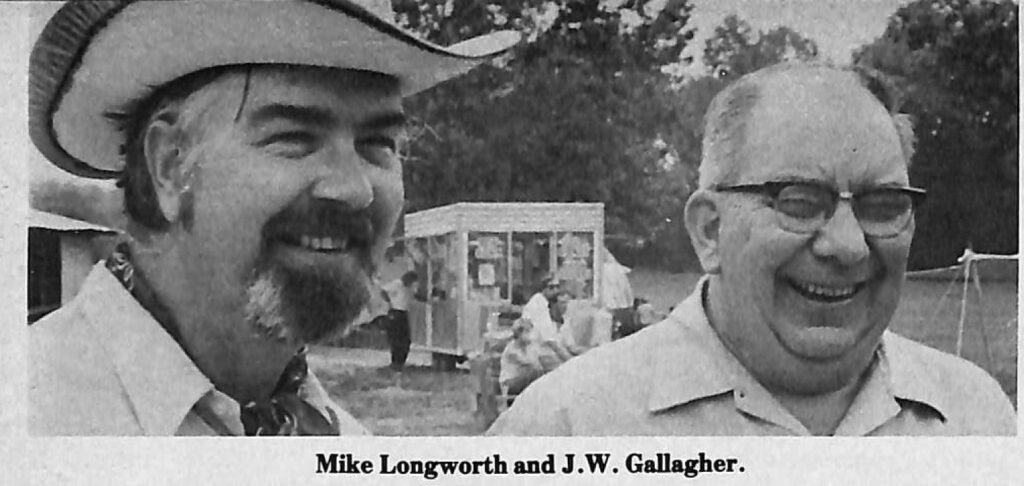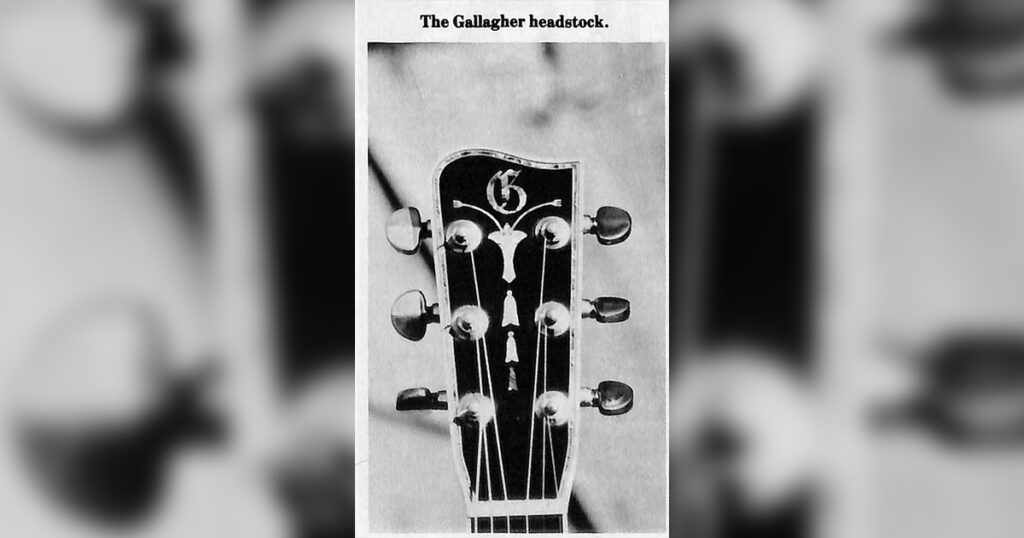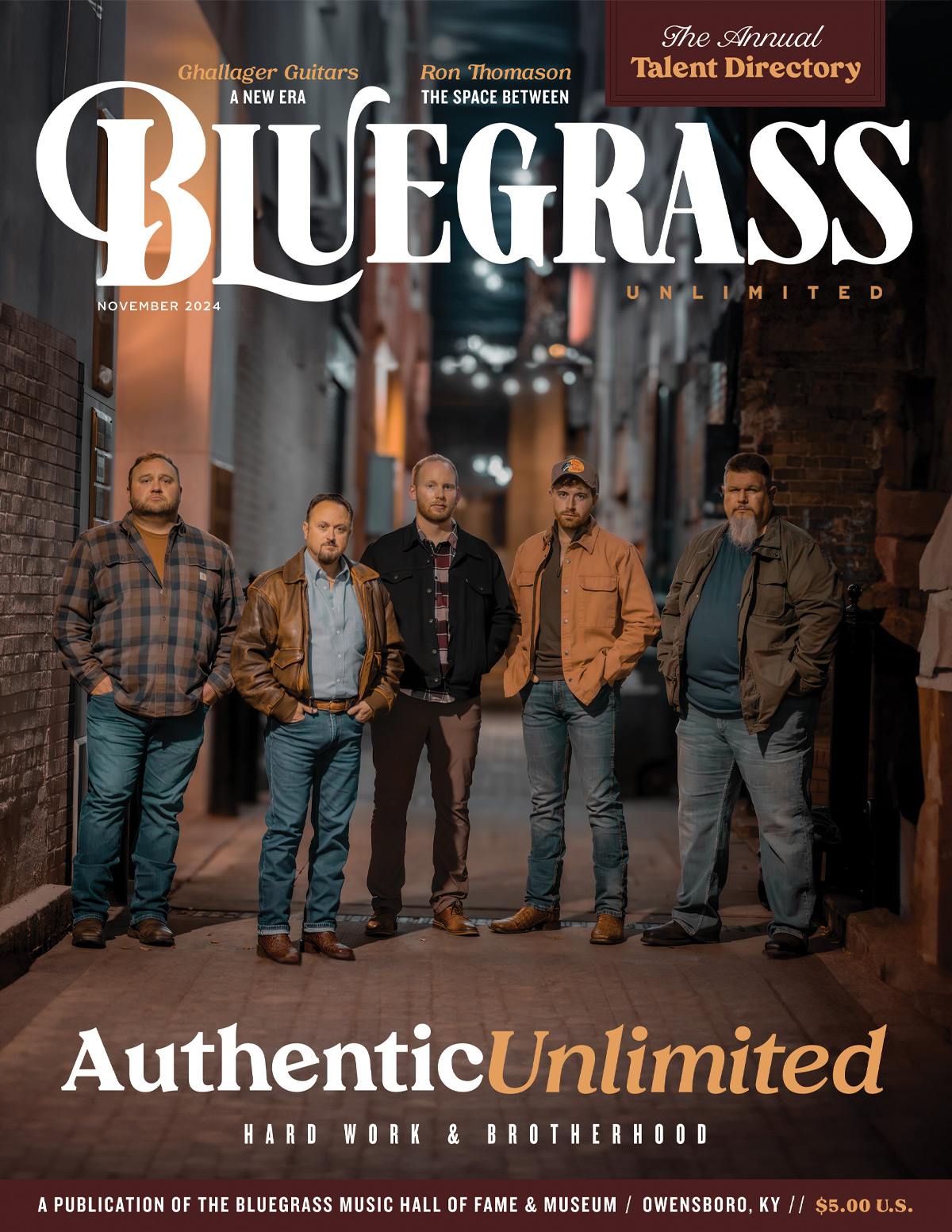Home > Articles > The Archives > The Basic Goodness of J. W. Gallagher
The Basic Goodness of J. W. Gallagher
Reprinted from Bluegrass Unlimited Magazine
August 1979, Volume 14, Number 2
A couple of summers ago in Harris, North Carolina, guitar maker John William Gallagher sat on a board stretch across some concrete blocks for seating at a bluegrass festival and remarked, “I don’t play myself, but I take pleasure in others enjoying what I make. I still get a big thrill hearing good music come out of one of my instruments.”
What brought that afternoon to mind was Mike Longworth, the field representative for the C.F. Martin Company, calling me from his Nazareth, Pennsylvania, office to let me know his friend, “J.W.,” had died a few days earlier on June 21, 1979.
If you mentioned the name J.W. Gallagher, most people connected with bluegrass, country or rock music would not recognize it, but if you mentioned the name “Gallagher Guitar,” any musician worth his salt would know exactly what you are talking about.
The hand crafted instruments constructed in the J.W. Gallagher and Son company in Wartrace, Tennessee, some 50 miles south of Nashville, represent quality workmanship recognized by such owners of Gallagher guitars as Steve and Randy Scruggs, Neil Diamond, Grandpa Jones, Doc and Merle Watson and several Nashville session musicians.
For a price list distributed by his company, Gallagher himself proudly observed, “I originated the design of the Gallagher guitar; a design that must be good because a lot of people love to copy it and didn’t ask us if we would mind. However, looking like us doesn’t mean that it is us. We have our own standard of workmanship and sound, the best that we can make, and I doubt if anyone can duplicate this on a conveyer belt.”
As a tribute to the work produced by his company – which was comprised of Gallagher, his son, Don, and four other people at the time of his death – the Country Music Association’s Hall of Fame building in Nashville has a special exhibit showing how a Gallagher guitar is constructed. Gallagher wrote in 1977 regarding the display saying, “We loaned the Hall of Fame a 71 Special guitar and some parts about two years ago for what was intended to be a display for 90 days. However, it attracted so much interest that they have made it a permanent display. This is all arranged in an eight foot long glass case, and they have leaflets explaining how the guitar is constructed. They also have on display Doc Watson’s first Gallagher, a G-50 that he had named Ol’ Hoss.”

In the premier issue of Frets magazine last March, Watson told interviewer Jon Sievert, “Then on Easter, J.W. and his son dropped by our house with three or four of their guitars. The house was full of people who had just come back from Union Grove (North Carolina). I played all the guitars and just before he left he came over and handed me the guitar that I’d liked the best. He said, “I want to give you this, and there are no strings attached except the ones on the guitar. We’ll just let the thing endorse itself if it is any good.” I used that guitar for eight years. Three years ago this September he came up to me in Nashville and told me he wanted to do something for me because I had sold more guitars than he could make, just by playing that guitar. I told him he could build me a new guitar with a neck to my specifications, and I sent him my ’53 Les Paul to copy. He copied the neck and shape, the fretboard and the type of frets, and made a guitar to suit himself. That’s what I have now.”
With permission from Watson, Gallagher created the “Doc Watson Model” guitar made of quarter sawn striped mahogany back and sides, herringbone style back-stripe and purfling with an ebony fingerboard and bridge.
Perhaps it was appropriate the last time I spoke in person to Gallagher was at the Exit Inn in Nashville where Doc Watson was performing. Gallagher was always very proud of his friend, Watson. Last year, shortly after an article I wrote about Watson appeared in Bluegrass Unlimited, I received a letter from Gallagher which noted, “I read the article in “Bluegrass Unlimited” about Doc Watson that you wrote and enjoyed it very much, and I am sure Doc appreciated the kind words you said about him.”
Gallagher was with his wife, Hazel, that day in Harris, North Carolina, I encountered him and Martin Guitar Company representative Mike Longworth for the first time. It amused me to see these two rival guitar company people together, because of the obvious genuine respect and friendship between Gallagher and Longworth. They kidded one another and played a game of “one-up-manship” or topping one another with boasts of which company had the best guitar.
Off to one side, however, Gallagher confided he had a lot of respect for Longworth’s craftmanship doing mother-of-pearl in-lay work for guitars owned by Hank Snow, Ernest Tubb and Merle Haggard. Longworth, likewise, admitted with a smile he admired Gallagher’s dedication to his art.
Before there was the Gallagher guitar shop, there was the Gallagher Cabinet Shop, first started in 1939 as a full time business. “The first woodworking project I ever did, though, was a fiddle I started at 10 and finished when I was 12. It became unglued in later years, and I put it in a box and eventually threw it away. I wasn’t that good, but I would give a $1,000 to get it back,” Gallagher recalled at the Harris festival.
Around 1963, Gallagher became shop supervisor at the Shelby Guitar Company located in Shelbyville, Tennessee, but the company folded after making about 100 guitars. Gallagher started his own company in 1965 with two employees. To date, more than 1,350 guitars with the famous “G” emblem on the neck have been constructed.
Gallagher was asked that afternoon if he felt like he was letting one of his own children go after working some six months on each guitar. He laughed and replied, “Not now, but I used to until after the first 1,000.”
When asked about any changes he saw coming for his company, Gallagher replied, “My son, Don, said his main ambition is to make guitars the same way 50 years from now as we are making today. I have made the remark I wouldn’t be production manager of a mass-produced guitar company for $1 million a year.
Another son, Bill, also has aided in the design and building of Gallagher guitars.
Longworth related that Gallagher apparently was stricken with a heart attack while in the Horseshoe Cafe, next door to his guitar shop. He died almost immediately. “We were real close, and his death has been very painful.”

He continued, “I was supposed to be at this house that week, because I spent three to four days each summer with him. Originally, he was supposed to be at a bluegrass festival that week, but he decided not to go because of the gas shortage. Two days before he died, he called me and told me to come on down and visit him, but I decided not to go, also because of the gas shortage.”
In an emotional voice, Longworth said, “With J.W., it was more camaraderie involved than competition. We had the greatest respect for each other.”
That sunny afternoon in Harris, as Doc Watson was preparing to go on stage with his Gallagher guitar, J.W. himself commented, “I take a lot of pride in my work. I have always enjoyed fine craftsmanship… When someone makes good music with one of my instruments, I feel like I’ve contributed something to his performance.”
Friends of John William Gallagher and fans of the Gallagher guitar will agree that he “contributed something” to the world of music.Friends of John William Gallagher and fans of the Gallagher guitar will agree that he “contributed something” to the world of music.
Share this article
1 Comment
Leave a Comment Cancel Reply
This site uses Akismet to reduce spam. Learn how your comment data is processed.


I have a 1965 Martin Guitar that i have always thought was the best.
I was wrong when I saw Doc Watson on stage and he was playing his Gallagher Guitar.
I went backstage to find out more about his guitar and talked at length a gentleman who told me all about “the Gallagher.”
Thank you for your article….it was ON POINT.